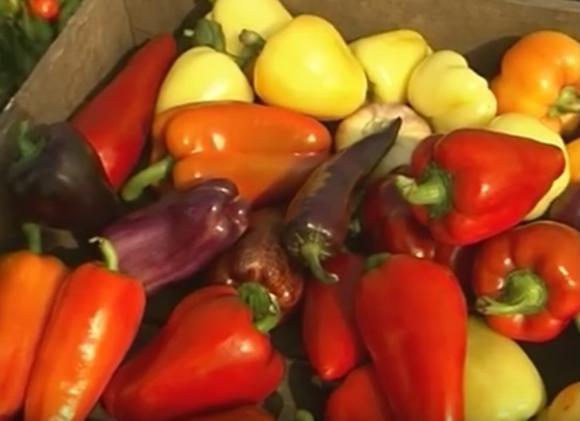 Unpretentiousness in growing and high productivity of plants is far from the only criterion for choosing new pepper seeds for future seedlings.
Unpretentiousness in growing and high productivity of plants is far from the only criterion for choosing new pepper seeds for future seedlings.
One of the main requirements is a suitable temperature regime for the growth of bushes and the formation of ovaries, as well as the possibility of growing on open ground under conditions of an unpredictable and often changeable climate.
Content
What is the difference between varieties
One of the main requirements when choosing suitable pepper seeds concerns the possibility of growing it on open ground, in a greenhouse or on the windowsill of a balcony in a multi-story building. In this case, compactness and maximum height of the bushes, as well as the need for tying them, are necessarily taken into account. For example, varieties with a height of not more than 30 - 40 cm can be used for planting on the windowsill.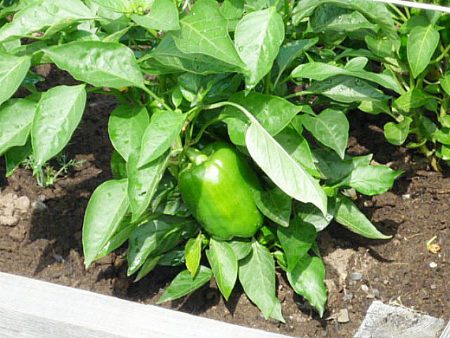
But there are a number of other equally important differences:
- Variety or hybrid. This criterion must be taken into account by those who want to use their own seeds for new seedlings next year. Hybrids (“F1” must be added to the name of the tomato on the packaging) are not suitable for such purposes and new packaging must be bought every year. This is due to the fact that the seeds obtained do not tend to inherit the varietal traits of the plant itself. New tomatoes can grow completely different not only in color and shape, but also in taste. At the same time, hybrids have significant advantages. First of all, this concerns the increased yield of bushes and the presence of immunity against many diseases.
- Ripening period. The best solution is to use different varieties of pepper with different ripening dates. This trick will allow for a long time to use fresh fruits in cooking, and then use part for canning for the winter. In this case, it is extremely important to take into account the particular climate in which pepper will be grown. For example, late-ripening varieties in regions with a cold climate and prolonged frost can be grown only in ennobled and heated greenhouses. If the territory is characterized by short summers and early autumn cooling, only plants with early ripening can be grown on open ground.
- Shape and size. This criterion is important for gardeners who want to use pepper as a decoration for a suburban area, as well as for the preparation of stuffed dishes. In the second case, thick-walled fruits with an oval or spherical shape of medium size (about 5-6 cm in length) will be relevant. Among the assortment of seeds, you can also choose the option with a conical or cylindrical shape. Peppers can also be cuboid, elongated (up to 19 - 22 cm), spherical and oval.
- Color. Thanks to a huge selection of colors, peppers serve not only as a taste, but also as a decorative decoration for fresh salads, hot dishes and even preservation for the winter. Most often, ripened peppers have a rich red, yellow or green hue.Of the brighter and more unusual options, it is worth highlighting a rich pink and orange color. During the ripening phase, some fruits tend to differ in purple, which is then gradually replaced by red. This is especially true for hybrids.
- Growing conditions. Of the mandatory requirements for growing peppers, it is worth highlighting protection from sudden cold snap, as well as the timeliness of irrigation of the soil with warm water (at least 25 - 28 degrees). On the packaging of seeds must indicate the possibility of growing a particular variety on the open ground, in a greenhouse or in greenhouses. In this case, special attention should be paid to permissible fluctuations in air temperature. Often varieties can be grown in areas with open ground, but at the same time they use temporary film shelters that protect plants from possible night frosts.
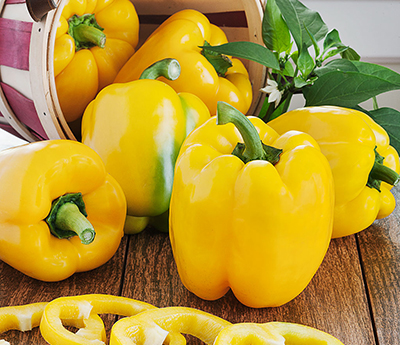
In the practice of experienced gardeners, it is also customary to pay attention to the height of the bushes, which can be either 30 - 35 cm or 150 - 180 cm. No less important are the requirements for the formation of the bush: clipping of the lower foliage and pinching of the side shoots. If pepper is grown for the purpose of further sale, gardeners should be interested in the keeping quality of the fruit, as well as the ease of preserving the original characteristics after a long transportation. In any of the options, the point concerning the resistance of the plants themselves to possible damage to various diseases is necessarily important. This will allow you to properly cultivate the soil and carry out effective prevention in advance.
Pepper Growing Rules
Each of the varieties of pepper has its own characteristics and requirements for growing. If some options tolerate drought more easily than stagnation of water, others are more patient with cooling, but may die due to drafts. At the same time, in the practice of gardeners there is a list of universal rules for the care of pepper plants, the observance of which will allow you to get a good harvest without any additional effort. This primarily concerns: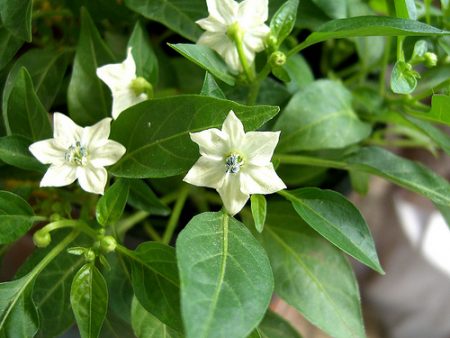
- compliance with the timing of sowing seeds (usually the first or second decade of February for warm regions and the first half of May for areas with a cold climate);
- germination of seeds even before sowing in the ground (this occurs by placing them between two cotton pads, plentifully sprinkled with water, which allows you to see the first seedlings already 3-5 days);
- planting seeds in separate opaque containers, which eliminates the need for picking plants;
- the need not to bury the seeds in the soil (not more than 2 mm);
- the necessary picking can be carried out by transshipment, filling the seeds in separate peat tablets or paper cups, with which the plant is transferred to a larger container, maintaining the entire formed root system intact;
- timely watering (stagnation of water should not be observed in the soil, but also drying out of the soil can significantly reduce the yield of cultivated bushes);
- the use of warm water in the irrigation process (about 28 - 30 degrees heat);
- the choice of a place for growth, which should be well lit by sunlight, be distinguished by fertile non-acidic soil and the absence of drafts;
- compliance with a suitable temperature regime, since pepper is a very heat-loving culture and the optimum air temperature is about 24 - 26 degrees Celsius;
- timely top dressing and mulching (covering the root system with a lightproof material in order to preserve moisture inside the soil, preventing its evaporation);
- obligatory weeding and loosening of soil after irrigation for sufficient access of oxygen.
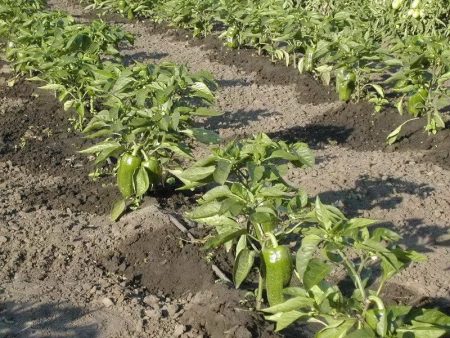
If the bushes differ in height, then the lower leaves must be cut off so that the tops do not come into contact with the ground. With the onset of September, only mature ovaries and ripening fruits should be left on the bushes. Emerging flowers break off so that the last harvest has the strength to ripen in time.
Varieties of bell pepper
Based on existing conditions, you can always choose the most suitable variety of pepper and try to grow it, both for food purposes and with the possibility of further sale.
Big mom
The variety of pepper Big Mama is an early ripe plant, which is characterized by increased productivity. The first ripe fruits can be expected by 125 - 130 days after the appearance of the first sprouts of seedlings. The variety is suitable for cultivation on open ground, as well as in greenhouse conditions. The average height of the bushes is 50 - 70 cm.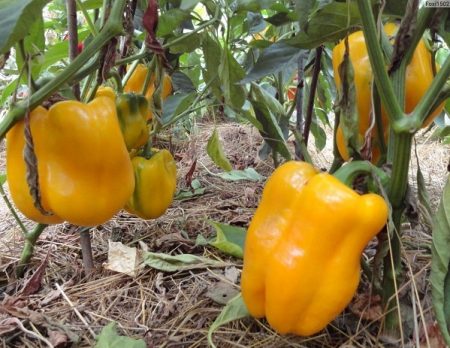
The demand for the Big Mama variety is due to the balanced sweet taste and juiciness of the fruits. The pepper itself has a rectangular shape and an average weight of about 200 g. The wall thickness is about 6 - 8 mm, which gives the necessary crispness of vegetables. Bright orange color allows you to use pepper, at the same time as a flavoring and decorative ingredient in dishes. Moreover, it is successfully used fresh, and is also suitable for stuffing, stewing and canning for the winter.
Of the recommendations for cultivation, it is worth highlighting the need to comply with crop rotation principles: pepper can be planted on soils where cucumbers, cabbage or legumes were grown before. It is not recommended to use areas where tomatoes were previously grown or any other nightshade plants. You can transplant seedlings to a permanent place at the age of at least 70 - 80 days. In this case, the distance between the holes is about 40-60 cm.
An important requirement for planting in open ground is the termination of night spring frosts and soil warming up to 16 - 18 degrees Celsius. Typically, this occurs in late May or early June. Since the bushes are tall enough and have large fruits, they need a careful garter to additional support. In this case, it is better to use the trellis method. Harvesting usually begins with the advent of August and lasts until mid-September.
Hero
The demand for the Bogatyr pepper variety among experienced gardeners is due to the ability to get a juicy tasty fruit crop while observing the most minimal growing and care requirements. Plants are really unpretentious and retain the ability to form ovaries when adverse weather conditions occur.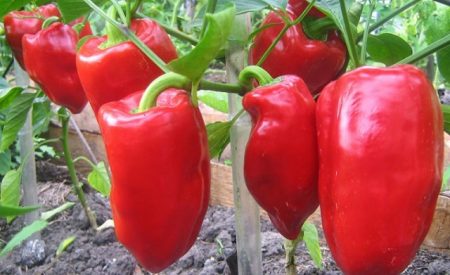
The only significant minus of the variety concerns the vulnerability of its plants to diseases, in particular damage to aphids. At the same time, verticillosis, vertex rot and tobacco mosaic are not afraid of these bushes. Reliable prevention of the manifestation of alternariosis and septoria is compliance with crop rotation rules: re-planting of pepper in one area is possible not earlier than after 3-4 years. To prevent damage to the root system with a black leg, the seeds are sown for 20-30 minutes in a light pink solution of potassium permanganate before sowing.
The variety belongs to the category of mid-ripening plants, and ripened fruits differ in wall thickness of about 6 - 8 mm and an average weight of 180 - 210 grams. The height of the bush can reach 30 - 50 cm. In this case, the plant develops quite well even in conditions of insufficient daylight. The variety is suitable for cultivation for the purpose of further sale, as it easily tolerates long transportations and is distinguished by the ability to collect about 8 - 9 kg of crop per 1 sq.m.
To get a good crop, it is necessary to pre-treat the seeds with a special 5% saline solution, in which they are soaked for 20 to 30 minutes. If, after soaking, some seeds rise to the surface, then they must be thrown away, since they are not suitable for planting and will not give sprouts. A picking of future bushes is allowed in the presence of 3 - 4 full-fledged leaves.
Swallow
The characteristic ability to form ovaries when adverse weather conditions occur is one of the main advantages of the Lastochka pepper variety, which makes the plants suitable for growing in regions with a changing and very unpredictable climate.
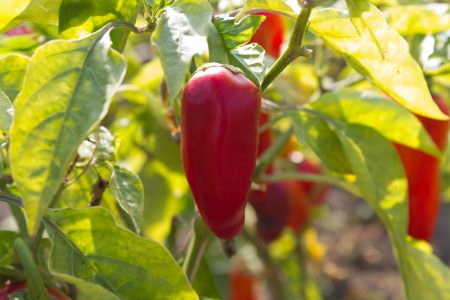
The fruits of the plant are large, sweet and fleshy. High productivity provides the opportunity to collect about 5 - 6 kg of fruit per 1 sq.m. The weight of one fruit is 70 - 90 grams. The shape of the pepper is conical, and the height of the bushes themselves can reach 55-60 cm. The growing season lasts about 116-120 days. To get aromatic ripe fruits, sowing seedlings should be planned at the end of February. At the same time, containers with soil and seeds must be covered with transparent glass or a protective film. As soon as the first sprouts appear, the shelter is completely removed.
Excessive humidity, as well as prolonged drought of the soil, can lead to the death of the emerging seedlings. To prevent weakening of the root system due to the necessary pick (which takes place in early April), the seeds can be planted in separate small containers with opaque walls.
If pepper is planned to be planted in open areas of soil, for two weeks before planting the bushes, they are hardened in the fresh air and under the influence of direct sunlight. Open balconies are best suited for this, and at night the plants again hide in a warm room.
So that the seedlings are strong enough, they must be fed with potash fertilizers. This is what increases the pain tolerance of the bushes, which means that it guarantees a good harvest.
Atlant
Atlant pepper variety is suitable for cultivation in conditions of unforeseen cold snap and frequent changes in weather, because it rises quickly and ripens, and the first fruits can be used in work by the end of June. At the same time, the pepper itself is distinguished by its large size, juicy crisp flesh and sweet taste. The biological maturation of the plant is evidenced by the acquisition of a saturated red color.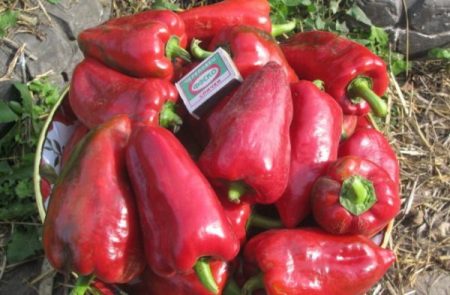
The average weight of Atlant pepper is about 100 - 170 grams. Technical ripening of the pepper occurs in 110 - 115 days from the moment of the appearance of the first shoots, and biological - after 130 - 140 days. Subject to the minimum care requirements, you can expect to receive 4 - 7 kg of crop from 1 sq.m. if you start growing seedlings a little earlier, then during the season you can manage to collect two full crops.
To work with seedlings of Atlant pepper, special peat pots with a diameter of 10 cm are best suited. When planting in a permanent soil, the plant is laid together with such cups that possible injury to root systems as a result of picking is completely excluded. The optimal soil composition for growing bushes includes equal parts of garden soil, compost and sawdust. The last component can be replaced by coarse river sand, providing looseness of the soil and a sufficient supply of oxygen to the roots.
The seed planting depth should not exceed 1 cm, and it is possible to transplant mature seedlings at the age of 40-50 days. Of the mandatory conditions for hasty care, it is worth highlighting a two-week hardening of seedlings by putting it out in the open air. At first, the procedure lasts several hours, but then gradually increases to a whole day. At night, seedlings always hide in a warm room.
Belozerka
Variety of pepper Belozerka suitable for cultivation on open ground. In this case, the first crop should be expected after 135 - 145 days from the moment of the appearance of the first seedlings. The characteristic compactness of the bushes and a small height (about 70 cm) allows more economical use of the useful area of the garden, as well as the use of film shelter in case of unexpected night cooling.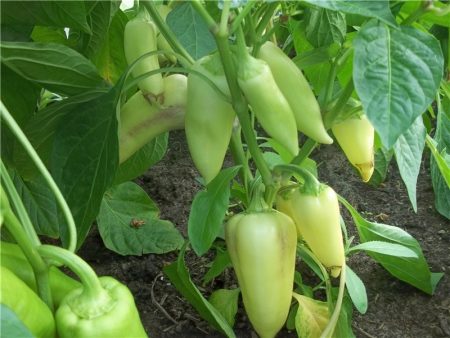
The shape of the fruit is conical with a pointed tip.The average weight of the pepper is about 90 - 140 grams. The smooth surface during ripening changes color from light green to rich red. From 1 sq.m. plot can be collected up to 8 - 10 kg of crop. The main feature of the variety is the increased content of vitamin C.
In order for the bushes to grow and develop well, seedlings should be planted at a distance of 50 - 55 cm. Among the important advantages of the Belozerka cultivar, it is also worth highlighting the presence of immunity against damage to verticillosis, vertebral rot and alternaria. Most viral infections are not scary for bushes.
Important! Watering pepper with warm water until flowering is recommended by sprinkling (so that water falls on the leaves), as soon as flowers begin to appear, irrigation is carried out in the direction of the root system. The optimal frequency of irrigation is at least 2 times for 7 to 10 days.
Big Dad
The main feature of the Big Papa variety is the acquisition by the peppers of an amazing purple color, which, with the onset of full biological maturity, becomes dark cherry. Plants belong to the category of early ripening and the growing season lasts only 96 - 104 days. Grow peppers, both in open ground and under protective film shelter.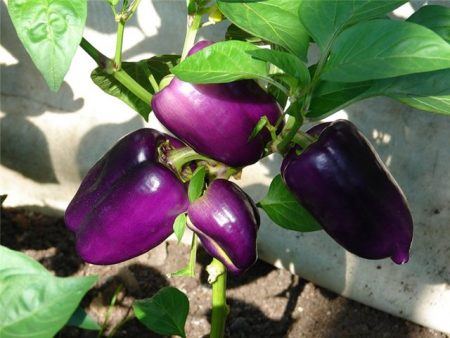
Bushes are not high enough and compact. They can be placed on 6 - 7 plants per 1 sq.m. This allows you to collect up to 6.9 - 7.5 kg of crop from the site. The weight of one fruit is 90 - 120 grams. Despite the unusual color, pepper is quickly used in fresh form, and is also suitable for canning. A balanced sweet taste has no bitterness, which is very appreciated by both gardeners and culinary specialists.
The variety is quite resistant to diseases such as verticillosis, fusariosis and aphid damage. Moreover, he is extremely difficult to tolerate the picking process. That is why it is recommended to grow seedlings in separate small containers with further transplantation into opaque glasses of 300 - 500 ml.
Since Big Papa pepper tolerates temperature differences quite easily, it can be grown in open areas in regions with a changing climate. If night spring frosts are expected, the bushes must be covered with a protective film. Short droughts are not afraid of the variety, but stagnation of water and cold drafts are extremely dangerous.
California Miracle
The ability to grow pepper California miracle in open fields with a variable climate and rely on high productivity of bushes determines the demand for the variety itself among experienced gardeners. An important advantage of the variety is also large fleshy fruits with a characteristic sweet taste.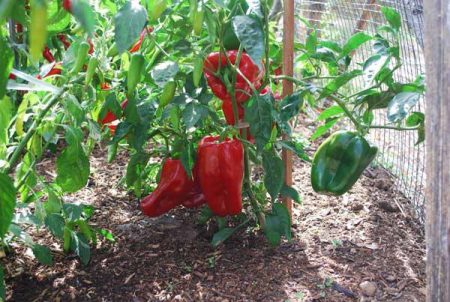
The height of the bushes can reach 50 - 70 cm, and the growing season is about 120 - 130 days from the moment the first shoots appear. The cuboid-ripened fruits have a weight of about 90 - 180 grams. In the process of development, the saturated green color of the fruit gradually changes to bright red. The fruits are universal in use, as they are suitable for fresh use, as well as for stuffing, stewing and preparing canned food for the winter.
To get a good yield, you should choose a seedling method of cultivation. At the same time, sowing of seeds is carried out at the end of February, and planting in the soil is allowed after the end of night spring frosts. To protect immature plants from changes in air temperature, they are covered with a film.
The California Miracle variety is resistant to diseases of Fusarium and Verticillosis. Early treatment of seeds with a weak solution of potassium permanganate will increase the resistance of the bushes to tobacco mosaic and damage by vertex decay.
Orange miracle
Sweet pepper Orange miracle belongs to the category of hybrids. Due to this, you can count on a balanced sweet taste, large-sized fruits of bright orange color, as well as good yield of planted seedlings.
Pepper Orange miracle belongs to the category of early ripening plants and the first ripened fruits can be harvested already 110 - 120 days after germination of the sprouts. The height of the bushes is 80 - 100 cm, and the cuboid fruits in their weight can reach 200 - 250 grams. Thus with 1 sq.m. the plot can be harvested more than 12 - 15 kg of crop, which is very much appreciated among gardeners who grow pepper for the purpose of further sale. Ripe fruits are suitable for fresh use, as well as preservation for the winter.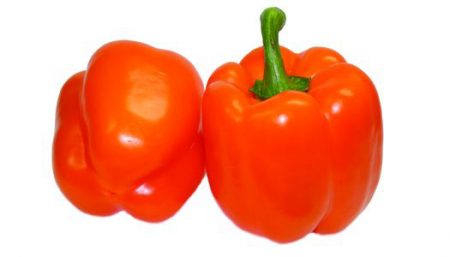
An important advantage of Orange Miracle Pepper is its resistance to temperature extremes and most fungal infections and microbial diseases. Due to this, the gardener is required to comply with the regime of watering the bushes and timely loosening of the soil with the introduction of mineral fertilizers.
From the nuances of cultivation, it is worth highlighting a painful reaction to a pick of the root system, which is important for most plants from nightshade cultures. To protect the seedlings, it is recommended to plant the seeds directly in separate small containers with soil. As the stems grow, they must be carefully transplanted into a container with a large volume, while transferring the entire handful of earth with the root system. The second important point concerns irrigation with exclusively warm water (at least 30 degrees).
If pepper is grown in closed greenhouses, it is highly undesirable to allow overdried air. Two weeks before planting in open ground, seedlings are subject to daily hardening by removal to fresh air for at least 3 to 4 hours. Pepper Orange miracle remains very sensitive to fertilizers, therefore, it is necessary to fertilize at least 3-4 times: when transplanting seedlings on a constant soil, 12-17 days after planting and before flowering.
Gogoshary
Resistant to unpredictable weather conditions, the Gogoshara pepper variety is distinguished by tomato-like rounded slightly flattened fruits of a dark red color. At the same time, the height of the bushes is about 50 cm, and the weight of the fruit can reach 80 - 145 grams.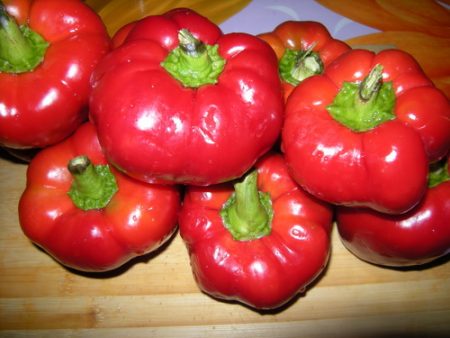
Gogoshary variety is suitable for lovers of a bitter taste in peppers with the addition of pungency. Despite the resistance to possible cold snap, a good pepper crop can be obtained if the air temperature does not fall below 18 - 22 degrees Celsius. For growing seedlings, it is worth choosing a room with a temperature of about 25 - 27 degrees. In this case, the soil should be characterized by moderate humidity, and the plants themselves require full ventilation. In addition to the mandatory picking, the variety is quite difficult to tolerate a change in the place of growth and pinching of the side shoots.
Gladiator
The bright yellow color of ripe pepper Gladiator is necessarily complemented by the presence of many useful trace elements, pectin and vitamin C, which allows the fruits to be used while observing the diet and for preparing children's dishes. Gladiator pepper is also suitable for people who are allergic to red vegetables.
The variety itself belongs to the category of mid-ripening plants and the first crop can be harvested after 110 - 120 days from the moment the first sprouts appear. The average height of the bushes is about 50 - 55 cm, which is important for the economical use of the soil in the greenhouse. In regions of the middle zone with an unpredictable climate, pepper can be grown on open ground, but at the same time, there should always be film protection in case of returning cold spring nights.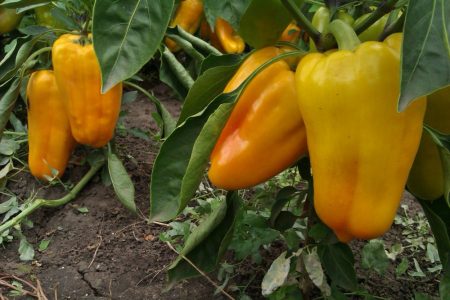
The fruits are quite large and weigh about 300 - 380 grams. The thickness of the fleshy and crispy walls is about 13 mm. The taste of pepper is balanced and sweet, without any bitterness, which is extremely important for use in the children's menu. The demand for the variety is also due to the universality of use, since pepper is suitable both for fresh consumption and as a winter preservation.
The variety is quite unpretentious and disease-resistant, therefore, only timely irrigation and weeding of the site, as well as loosening of the soil with 3 to 4 single-time soil fertilizers for the whole season, should be singled out from the mandatory requirements. If you follow the minimum rules, the fruiting period of the bushes will stretch for several months, from the second half of July to the first decade of October.
Gift of Moldova
For a successful cultivation in a mild climate, the Gift of Moldova pepper variety is also suitable. It belongs to the category of mid-ripening varieties and the first crop can be expected already on 125 - 135 days after the appearance of the first seedlings. The height of the bushes is only 45 - 55 cm, which is important to consider when preparing a protective film shelter.
As for the fruits, they differ in average size and weight of about 80 - 100 grams. The rich red color and meatiness of the peel preserves its crispness and balanced sweet taste. The use of pepper is quite universal, since the fruits can be used fresh, as well as for cooking stuffed dishes and winter canning.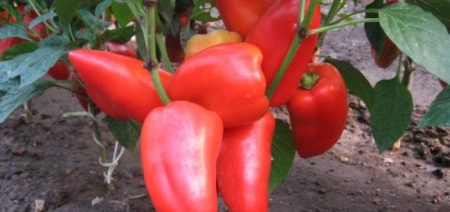
An important point concerns the need to pre-treat the seeds with a weak solution of potassium permanganate for 20 to 30 minutes. This will strengthen the immunity of plants and protect against late blight. As for rot, fusarium and spotting, they primarily occur with prolonged rainfall and too sharp temperature drops. As protection, a soda solution (250 g per 10 liters of water) or a two-day infusion of celandine (1 - 1.5 kg of freshly ground grass per 10 liters of water) can be used. The first such procedure can be carried out no earlier than two weeks after planting the bushes. Be sure to repeat the procedure after another 12 - 15 days.
If fungicides are used in pest control, all spraying should be carried out no later than two weeks before the planned harvest. In the process of autumn soil fertilization, you can use rotted compost or manure, and only mineral complexes are suitable for feeding planted seedlings. Another important point concerns the timely loosening of the soil so that the root system can be saturated with oxygen. If the air temperature is too high near the bushes, mulching is carried out - sheltering the root system with materials that do not allow sunlight. This will protect the soil from the loss of existing moisture by evaporation.
What varieties and types of pepper to plant in 2018
In the selection of seeds for growing seedlings this year should be based on their own needs, as well as the goals of further application of the crop. If most of the selected varieties should be well known and tested, then you can always allocate a part to the study of new varieties and their features.
Of the proven harvesting options, attention should be paid to the varieties of peppers Bogatyr, Hercules and the Gemini F1 hybrid.If the first option is characterized by average ripening and almost even identical tasty fruits, then Hercules is characterized by a cuboid shape and guaranteed resistance to unpredictable changes in weather conditions. The choice in favor of the hybrid can be determined by obtaining large sweet fruits with good keeping quality and the possibility of long-term transportation, which is extremely important when growing pepper for industrial purposes, for further sale.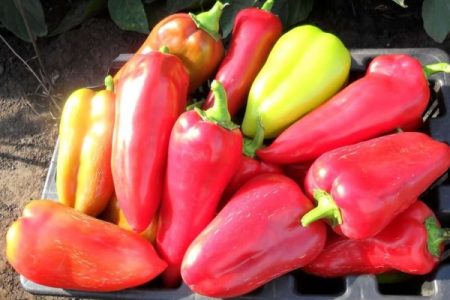
If you want to try something new, you should pay attention to the possibility of acquiring seeds of such varieties as Atlant, Tongue of Mother-in-law, as well as hybrids Santia and Patricia. The first two are characterized by thick fleshy walls and early ripening. And hybrids deserve attention, due to the increased yield and good resistance to the effects of various fungal infections and microbes.
From early ripening variants, hybrids of peppers called Apollo, Kakadu and Shuttle should also be studied. If the growth of bushes is planned on open ground, care should be taken in advance for reliable film protection. The variety Kupets is distinguished by abundant fruiting with the formation of sufficiently large pepper. In this case, the weight of the fetus is about 130 - 150 grams.
For gardeners who prefer an early harvest with a long fruiting period, it is worth paying attention to the Samander variety. It differs in the canonical shape of the fruit with the ability to harvest until late autumn.
Reviews
Vladislav Andreevich, 39 years old
In choosing the right pepper varieties, it is also important to consider the possibility of direct sowing in the soil with the design of a protective film tunnel. Thanks to this trick, seedlings will get stronger faster and will not lose productivity due to a picking of the root system or a change in the composition of the soil. When growing pepper in greenhouse conditions, one of the dangerous diseases is the spider mite, which manifests itself in an arid climate and in the absence of timely watering. In such cases, it is important to spray the bushes with a two-day garlic infusion (250 - 300 g of squeezed garlic per 10 liters of water), and the room itself should be well ventilated by adjusting the irrigation regime of the soil.
Elena Viktorovna, 38 years old
The variety of peppers Gogoshary is somewhat bitter, which should be considered when choosing new seeds for seedlings. To fully treat the soil before sowing seeds, you can use a boiling hot pink solution of potassium permanganate. They fill a container with laid soil, and on top everything is covered with a dense film. Such a trick will increase the efficiency of the procedure for the destruction of dangerous fungi and microbes by steaming. Planted seeds can only be planted in completely cooled soil.
Ksenia Vladimirovna, 47 years old
For additional protection of pepper bushes, onion or garlic husk can be added to the hole during transplantation. In the process of fertilizing with mineral complexes, it is recommended to select soluble substances and dilute with warm water immediately before irrigation. In this case, the direction of the water should concern the root system, and not the stems and leaves. It is recommended to use fertilizers no more than once every 3 to 4 weeks. The use of fresh manure or unripened compost is not allowed, since in such cases all the forces and substances go to the growth of the bush, and not the formation of ovaries.




 Calorie pepper stuffed with meat and rice - BZHU per 100 grams
Calorie pepper stuffed with meat and rice - BZHU per 100 grams Gorky pepper - the best varieties for open ground
Gorky pepper - the best varieties for open ground Hot pepper seeds - the best varieties for open ground and reviews
Hot pepper seeds - the best varieties for open ground and reviews Capsicum tincture for hair - how to use and reviews
Capsicum tincture for hair - how to use and reviews